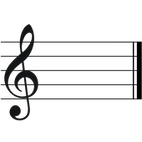Subtest III: Visual and Performing Arts Study Guide for the CSET Multiple Subjects Test
Page 2
Music
Music is a melodious sound produced by voice or with instruments containing rhythm, melody, and (usually) harmony.
For beginners, music is traditionally taught, rehearsed, and performed as a group activity. Solo performances are normally reserved for advanced/college-age students. Generally, a performance by intermediate students will not feature any solos.
There are a variety of traditional instruments (e.g., guitar, piano) and non-traditional instruments. Non-traditional instruments include:
- garbage cans
- pipes
- plastic tubing
- pots and pans
- electric buzzers
Anything that can produce a sound can be considered an instrument.
Note: The word music is also used as shorthand for the term “sheet music.” Another way to refer to sheet music is as “the score.”
Knowledge
A music teacher needs to be well-versed in the basics of music:
- music theory
- methods of teaching
- practical application (playing an instrument)
- conducting (leading the band/orchestra)
- public speaking
Many music teachers are professional or semi-professional musicians and perform outside of school.
Elements of Music
There are nine elements of music. The most important elements beginning students are taught are pitch, rhythm, and harmony. As the student becomes more experienced, the other five elements can be added.
Pitch—Pitch is the place on the scale as noted in the sheet music. It is determined by the frequency of the vibration. Larger objects vibrate slower. Slower vibrations create lower notes. Larger instruments create slower vibrations (lower notes).
Is the student playing the right note? On a piano, it is straightforward: press a key, a sound comes out. On a trumpet, it is a little more complicated: the right combination of valves must be pressed and the embouchure (mouth position) must be correct. A slide trombone has no valves so the player must find the correct slide position, often correcting this position “by ear.”
Rhythm—Rhythm is the pattern of the sounds produced. Long-duration notes combined with short-duration notes produce the rhythm. When teaching beginning students, often a teacher will clap out the rhythm of a piece to demonstrate.
Rhythm is different from beats. The beats are regular and do not change from measure to measure (except for tempo changes and time signature changes, which will not be present in beginning music).
Harmony—Harmony is the notes played that aren’t the melody. The harmony supports the melody and adds richness to the sound. Usually, the melody and the harmony are played in combinations called chords. The harmony is generally played softer than the melody, as it supports the melody.
The Other Six Elements
The previous elements are introduced to beginning students once they have mastered the basics of producing sounds with their instruments. Intermediate students will spend more time working on the following additional elements. Advanced students will strive to master these as well:
-
Time (also called beat or meter)—Time is the regular count of the music (this is covered in more detail in the “Performing and Creating Music” section).
-
Dynamics—Dynamics are the volume of the played note and how the music increases or decreases in volume.
-
Melody—Melody is a string of notes that produces a cohesive tune.
-
Tempo—Tempo is the speed at which the music is played, as controlled by the conductor and usually suggested by notation in the sheet music.
-
Texture—Texture is the number and types of layers to the music. Barbershop quartets have exactly four layers. Orchestras have many more layers. A violin duet will have fewer layers.
-
Timbre—Timbre is the sound quality or “color” of the music, especially as produced by different instruments. A trumpet produces a different sound than a bassoon; they have different timbres. The timbre of an instrument can be changed by a skilled musician.
Improvising
Making the music up as you go is called improvisation. It can be an excellent exercise or warm-up activity. For anyone that is attempting to compose new material, improvisation is essential. Improvised music is rarely used as part of a public performance. Improvising music is much easier while singing than with an instrument.
How to Improvise Music
Improvisation is not easy. It requires practice. Start small:
- Make changes to a song that is already in your repertoire.
- Play in a different octave than you normally play.
- Find a new harmony to the melody (a third or fifth lower).
- Create a more complicated harmony.
- Find variations to the melody and/or rhythm.
It is important to record some of your improvisations, so you can critique them and improve.
Making Connections
Music is usually a group activity, especially at the beginning level. Improvisation is no exception. Working together on improvisation can produce wonderful results.
Performing and Creating Music
The basics for music (with regard to beginning students) are to keep careful control of the tonality and meter. Attention to each will dramatically improve a recital performance. After a student learns basic control of an instrument, these are the next two things taught.
Tonality
Tonality is the key in which a song is performed. The key is shown by the key signature in the printed sheet music. All the students must be able to read the key signature and be ready for any sharps or flats in the piece. Here are some examples of key signatures and their corresponding keys:
 C major or A minor
C major or A minor
no flats or sharps
Retrieved from: Key signature. (2023, February 1). In Wikipedia. https://en.wikipedia.org/wiki/Key_signature
 F major or D minor
F major or D minor
one flat
Retrieved from: Key signature. (2023, February 1). In Wikipedia. https://en.wikipedia.org/wiki/Key_signature
 D major or B minor
D major or B minor
two sharps
Retrieved from: https://upload.wikimedia.org/wikipedia/commons/thumb/d/d3/D-major_b-minor.svg/1280px-D-major_b-minor.svg.png?20220406102556

G♭ major or E♭ minor
six flats
Retrieved from: Key signature. (2023, February 1). In Wikipedia. https://en.wikipedia.org/wiki/Key_signature
A teacher must be able to read the music well enough to assist the student in playing all the notes. Beginning music will rarely have more than two sharps or flats. A teacher should not ask a high school student to play music with more than four sharps or flats. There are several tricks that a music teacher can use to quickly identify the key. A reference chart can also help.
 Circle of fifths
Circle of fifths
Retrieved from: Just plain Bill, CC BY-SA 3.0 http://creativecommons.org/licenses/by-sa/3.0/, via Wikimedia Commons
Meter (or Beat)
Meter is the constant beat defined by the time signature.
 Drum music
Drum music
Retrieved from: Half-time (music). (2023, February 7). In Wikipedia. https://en.wikipedia.org/wiki/Half-time_(music)
The above is a very common drum pattern, especially for rock. The notation at the top left shows that there are between 80 and 160 beats per minute. Each quarter note gets a single beat.
On the staff (left to right), these are the symbols to understand:
- two short, thick vertical lines (denote this as drum music)
- a “repeat” (a thick bar, a thin bar, then a colon) indicates this section will be repeated

- 4/4 time signature
- the musical notes
- the matching “repeat” indicates the end of the section to be repeated

The notes are:
- The bass drum is played on beats 1 and 3.
- The snare drum is played on beats 2 and 4.
- The hi-hat is played as eight notes throughout.
In 4/4 time, the top 4 means that each measure will have four beats and the bottom 4 signifies that a quarter note will get one beat.
 Commonly found time signatures
Commonly found time signatures
Retrieved from: https://upload.wikimedia.org/wikipedia/commons/6/64/Common_time_signatures.gif
From left to right, the symbols are:
- treble clef
- 4/4—four beats per measure/quarter notes get one beat
- common time (a different way of expressing 4/4)
- 2/2—two beats per measure/half notes get one beat
- cut time (a different way of expressing 2/2)
- 2/4—two beats per measure/quarter notes get one beat
- 3/4—three beats per measure/quarter notes get one beat (also called “waltz time”)
- 6/8—six beats per measure/eighth notes get one beat (also called “minuet time”)
You will often see musicians tap out the beat with their toes while playing. As a music teacher, you will be expected to conduct the band/orchestra during recitals and other public demonstrations. You will control the meter by your pattern of baton movements.
Musical Ideas and Connections
As a teacher, you want to expose your students to as many forms of music, methods of play, and styles of presentation as possible as a method of bringing music to many lives. Often, though, there is a performance to be considered or a student concert or public recital to be readied. This will involve selecting music and training the students.
Societal Context
There is always a temptation to perform music that is avant-garde and challenging for the audience to understand. But if the audience does not understand the music, it will not be enjoyed. Music should be picked to entertain (among other considerations).
Cultural Context
The music should be culturally appropriate. The goal is to connect with the audience. Selecting music for a festival or theme event can be tricky, as it is important to carefully match the type of music to that theme or festival purpose. Music selected for a Wild West event would be very different from music selected for a Renaissance fair.
Historical Context
Classical music is often described as “stuffy,” which it can be. But there are many exciting, lively classical pieces that can be played by high school or junior high school orchestras. Music from other periods can also be interesting to perform and listen to. Madrigals (written in the Middle Ages) are often within the abilities of intermediate students.
Selecting Music
Music should connect with the audience. If the audience is unable to engage with the performance, it will not be enjoyable. You should consider the following ideas when selecting music for a performance.
Purpose
When preparing a concert or recital, care must be taken that the material is not only age- and skill-appropriate music but that the audience will enjoy the music.
Personal Influence
We all have personal likes and dislikes. As a music teacher, it is important to share your passion for music without fixating on a single style or performance method.
Interests
Often there will be local favorites. While performing music at a festival, it is particularly important to “play to the event.”
Experiences
Years of experience will provide a music teacher with many examples of music that they would like to perform someday. Inspiration can come from concerts, music heard on the radio, recordings, etc. When you hear a particularly interesting piece, take notes concerning:
- the name of the piece
- the composer
- appropriateness for intermediate students
- appropriateness for advanced students
- tempo
All Study Guides for the CSET Multiple Subjects Test are now available as downloadable PDFs